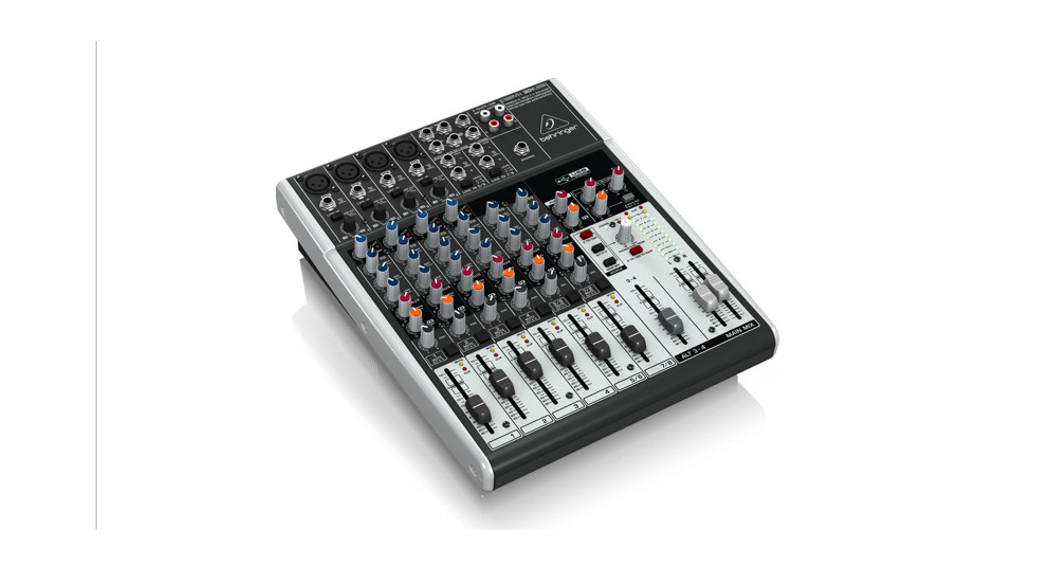 Quick Start GuideXENYXQ1202USB/Q1002USB/Q802USB/Q502USB
Quick Start GuideXENYXQ1202USB/Q1002USB/Q802USB/Q502USB


Premium 12/10-Input 2-Bus Mixer with XENYX Mic Preamps & Compressors, British EQs, Klark Teknik Multi-FX Processor, and USB/Audio Interface
Important Safety Instructions
| CAUTION RISK OF ELECTRIC SHOCK! DO NOT OPEN |
![]()
![]()
![]()
![]()
![]()
![]()
![]()
![]()
![]()
![]()
![]()
![]()
![]()
![]()
![]()
![]()
![]()
![]()
- Read these instructions.
- Keep these instructions.
- Heed all warnings.
- Follow all instructions.
- Do not use this apparatus near water.
- Clean only with a dry cloth.
- Do not block any ventilation openings. Install in accordance with the manufacturer’s instructions.
- Do not install near any heat sources such as radiators, heat registers, stoves, or other apparatus(including amplifiers) that produce heat.
- Do not defeat the safety purpose of the polarized or grounding-type plug. A polarized plug has two blades with one wider than the other. A grounding-type plug has two blades and a third grounding prong. The wide blade or the third prong is provided for your safety. If the provided plug does not fit into your outlet, consult an electrician for the replacement of the obsolete outlet.
- Protect the power cord from being walked on or pinched particularly at plugs, convenience receptacles, and the point where they exit from the apparatus.
- Use only attachments/accessories specified by the manufacturer.


- Use only with the cart, stand, tripod, bracket, or table specified by the manufacturer, or sold with the apparatus. When a cart is used, use caution when moving the cart/apparatus combination to avoid injury from tip-over.
- Unplug this apparatus during lightning storms or when unused for long periods of time.
- Refer all servicing to qualified service personnel. Servicing is required when the apparatus has been damaged in any way, such as power supply cord or plug is damaged, liquid has been spilled or objects have fallen into the apparatus, the apparatus has been exposed to rain or moisture, does not operate normally, or has been dropped.
- The apparatus shall be connected to a MAINS socket outlet with a protective earthing connection.
- Where the MAINS plug or an appliance coupler is used as the disconnect device, the disconnect device shall remain readily operable.


- Correct disposal of this product: This symbol indicates that this product must not be disposed of with household waste, according to the WEEE Directive (2012/19/EU) and your national law. This product should be taken to a collection center licensed for the recycling of waste electrical and electronic equipment (EEE). The mishandling of this type of waste could have a possible negative impact on the environment and human health due to potentially hazardous substances that are generally associated with EEE. At the same time, your cooperation in the correct disposal of this product will contribute to the efficient use of natural resources. For more information about where you can take your aste equipment for recycling, please contact your local city office or your household waste collection service.
- Do not install in a confined space, such as a bookcase or similar unit.
- Do not place naked flame sources, such as lighted candles, on the apparatus.
- Please keep the environmental aspects of battery disposal in mind. Batteries must be disposed of at a battery collection point.
- This apparatus may be used in tropical and moderate climates up to 45°C.
LEGAL DISCLAIMER
Music Tribe accepts no liability for any loss which may be suffered by any person who relies either wholly on or in part upon any description, photograph, or statement contained herein. Technical specifications, appearances, and other information are subject to change without notice. All trademarks are the property of their respective owners. Midas, Klark Teknik, Lab Gruppen, Lake, Tannoy, Turbosound, TC Electronic, TC Helicon, Behringer, Bugera, Oberheim, Auratone, and Coolaudio are trademarks or registered trademarks of Music Tribe Global Brands Ltd. © Music Tribe Global Brands Ltd. 2021 All rights reserved.
LIMITED WARRANTY
For the applicable warranty terms and conditions and additional information regarding Music Tribe’s Limited Warranty, please see complete details online at musictribe.com/warranty.
Step 1: Hook-Up
Live Performance


Home Studio
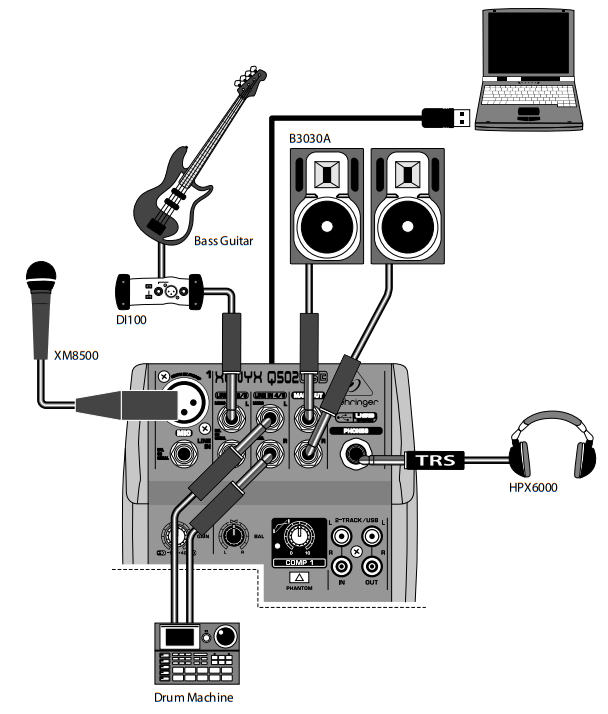

Recording Studio
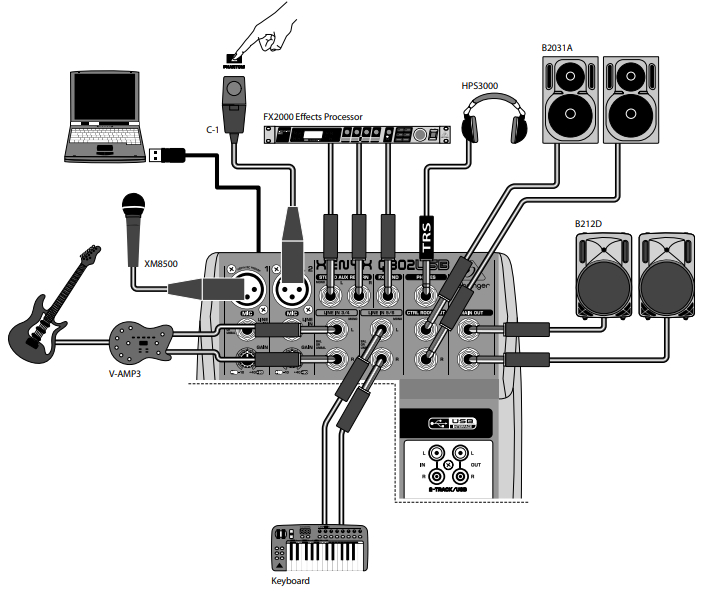

Step 2: Controls
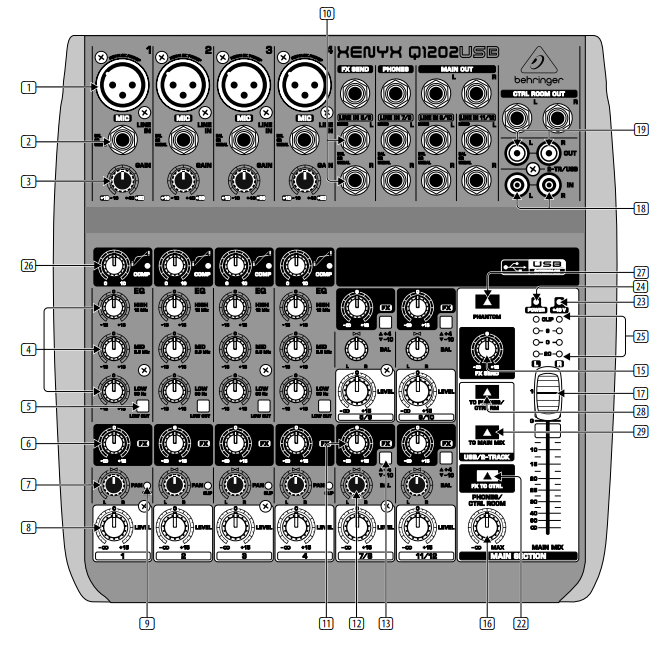



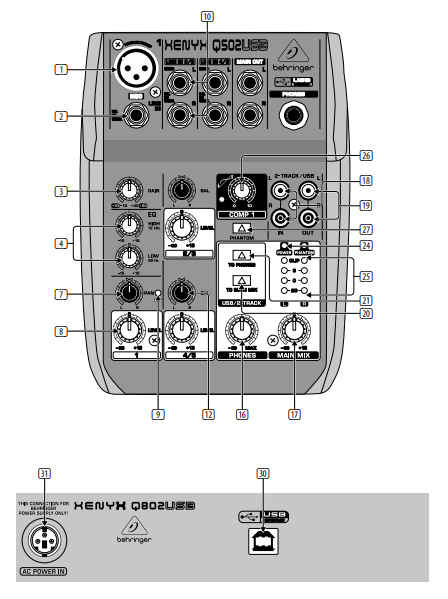

- MIC – Each mono input channel offers a balanced microphone input via the XLR connector and also features a switchable +48 V phantom power supply for condenser microphones. The XENYX preamps provide undistorted and noise-free gain as is typically known only from costly outboard preamps.
- LINE IN – Each mono input also features a balanced line input on a ¼” connector. Unbalanced devices (mono jacks) can also be connected to these inputs. Please remember that you can only use either the microphone or the line input of a channel at any one time. You can never use both simultaneously!
- GAIN – Use the GAIN control to adjust the input gain. This control should always be turned fully counterclockwise whenever you connect or disconnect a signal source to one of the inputs.
- EQ – All mono input channels include a 3-band equalizer. All bands provide a boost or cut of up to 15 dB. In the central position, the equalizer is inactive.
- LOW CUT – In addition, the mono channels are equipped with a steep LOW CUT filter designed to eliminate unwanted low-frequency signal components.
- FX – FX sends enable you to feed signals via a variable control from one or more channels and sum these signals to a bus. The bus appears at the console’s FX send the output and can be fed from there to an external effects device. The return from the effects unit is then brought back into the console on the stereo channels. Each FX send is mono and features up to +15 dB gain. In the QX1002USBQX1202USB, the FX send is routed directly to the built-in effects processor. To make sure that the effects processor receives an input signal, you shouldn’t turn this control all the way to the left (-∞).
- PAN – The PAN control determines the position of the channel signal within the stereo image. This control features a constant-power characteristic, which means the signal is always maintained at a constant level, irrespective of position in the stereo panorama.
- LEVEL – The LEVEL control determines the level of the channel signal in the main mix.
- CLIP – The CLIP LEDs of the mono channels illuminate when the input signal is driven too high, which could cause distortion. If this happens, use the GAIN control to reduce the preamp level until the LED does not light anymore.
- LINE IN – Each stereo channel has two balanced line-level inputs on ¼” jacks for left and right channels. If only the jack marked “L” (left) is used, the channel operates in mono. The stereo channels are designed to handle typical line-level signals. Both inputs will also accept unbalanced jacks.
- FX – The FX sends of the stereo channels function similar to those of the mono channels. However, since the FX send buses are both mono, a mono sum is first taken from the stereo input before it is sent to the FX bus. The Q502USB is not equipped with FXsends.
- BAL – The BAL(ANCE) control determines the levels of the left and right input signals relative to each other before both signals are then routed to the main stereo mix bus. If a channel is operated in mono via the left line input,this control has the same function as the PAN control used in the mono channels.
- +4/-10 – The stereo inputs of the XENYX Q1002USB and Q1202USB have an input sensitivity switch that selects between +4 dBu and -10 dBV. At -10 dBV (home-recording level), the input is more sensitive (requires less level to drive it) than at +4 dBu (studio level).
- STEREO AUX RETURN – Q802USB only: the STEREO AUX RETURN connectors are used to bring the output of the external effects device (whose input is derived from the aux sends) back into the console. You can instead use these connectors as additional inputs, but any effects device will then have to be brought back into the console via a normal stereo channel. This does, however, give you the ability to use the channel EQ on the effects return signal if you wish. If only the left connector is used, the AUX RETURN automatically operates in mono. Use the AUX RETURN control to determine how much of the effects signal is sent to the main mix.
- FX SEND – The FX SEND output (does not apply for Q502USB) should be connected to the input of an external effects unit. The post-fader FX signal you created using the input channel FX controls is sent to the effects unit via the FX SEND output. Use the FX SEND control of the main section to adjust the overall send level (Q1002USB and Q1202USB only).
- PHONES/CTRL ROOM – The stereo PHONES jack (at the top of the connector panel) is where you connect headphones. The unbalanced CTRL ROOM OUT jacks carries the summed effects and main mix signals, as well as soloed channel signals. The PHONES/CTRL ROOM control adjusts the level of both headphones and main monitor outputs. The Q502USB is not equipped with control room outputs.
- MAIN MIX – The MAIN OUT connectors are unbalanced mono jacks. The main mix signal appears here at a level of 0 dBu. The MAIN MIX fader adjusts the volume of these outputs. The XENYX Q802USB and Q502USB mixing consoles feature a rotary control for this purpose.
- 2-TRACK INPUT – The 2-TRACK INPUTs are used to bring an external signal source (e.g. CD player, tape deck, etc.) into the console. They can also be used as a standard stereo line input, so the output of a second XENYX or BEHRINGER ULTRALINK PRO MX882 can be connected.
- 2-TRACK OUTPUT – These connectors are wired in parallel with the MAIN OUT and carry the main mix signal (unbalanced). Connect the 2-TRACK OUTPUT to the inputs of your recording device. The output level is adjusted via the high-precision MAIN MIX fader or rotary control (Q802USB/Q502USB).
- USB/2-TR to MAIN – When pressed, this button sends the audio from the USB and 2-TRACK inputs to the main mix(Q502USB only).
- USB/2-TR to PHONES – When pressed, this button sends the audio from the USB and 2-TRACK inputs to the PHONES jack (Q502USB only).
- FX TO CTRL ROOM – If you want to monitor only the FX send a signal in your headphones or monitor speaker(s), press the FX TO CTRL switch. This mutes the main mix signal while routing the FX SEND output to the monitor(s). The XENYX Q802USB and Q502USB do not feature this switch.
- +48 V – The red +48 V LED lights up when phantom power is on. The PHANTOM switch activates the phantom power supply on the XLR connectors of all mono channels.
- POWER – The POWER LED indicates that the console is powered on.
- LEVEL INDICATOR – The high-precision 4-segment display accurately displays the relevant signal level.
- COMP – This knob adjusts the amount of compression effect on the channel.
- PHANTOM – Press this knob to send +48 V of phantom power to the XLR inputs for use with condenser microphones. The Q502USB supplies +15 V of phantom power.
- USB/2-TR TO PHONES/CTRL RM – button routes USB/2-Track playback to PHONES/CTRL ROOM.
- USB/2-TR TO MAIN MIX – button routes USB/2-Track playback to MAIN MIX and mutes the 2-TR OUT/USB recording signal.
- USB CONNECTOR – Connect your mixer to a computer using a standard USB cable.
- AC POWER IN – Connect the included power cable here.
![]()
![]()
Step 3: Level Setting
To correctly set the gains of the channels, first set the LEVEL controls of the input channels to their center positions (0 dB). Then use the GAIN controls to increase the input amplification until signal peaks show 0 dB on the level meter.
When recording to digital recorders, the recorder’s peak meter should not go into overload. While analog recorders can be overloaded to some extent, creating only a certain amount of distortion (which is common and often desirable), digital recorders distort quickly when overloaded. In addition, digital distortion is not only undesirable but also renders your recording completely useless. The peak meters of your XENYX display the level virtually independent of frequency. A recording level of 0 dB is recommended for all signal types.
|
Mono Inputs |
||||
|
Microphone Inputs |
||||
| Type | XLR connector, balanced, the discrete input circuit | |||
| Mic E.I.N. (20 Hz – 20 kHz) | ||||
| @ 0 Ω Source resistance | -134 dB / 136 dB A-weighted | |||
| @ 50 Ω Source resistance | -131 dB / 133 dB A-weighted | |||
| @ 150 Ω Source resistance | -129 dB / 131 dB A-weighted | |||
| Frequency Response (-1 db) | <10 Hz – 150 kHz (-1 db) | |||
| Frequency Response (-3 db) | <10 Hz – 200 kHz (-3 db) | |||
| Gain range | +10 dB to +60 dB | |||
| Max. input level | +12 dBu @ +10 dB Gain | |||
| Impedance | 1.9 kΩ balanced 1.9 kΩ balanced 1.9 kΩ balanced 1.4 kΩ balanced | |||
| Signal-to-noise ratio | 110 dB A-weighted (0 dBu In @ +22 dB Gain) | |||
| Distortion (THD+N) | 0.005% / 0.004% A-weighted | |||
| Line Inputs | ||||
| Type | ¼” TRS connector, balanced | |||
| Impedance | 20 kΩ balanced, 10 kΩ unbalanced | |||
| Gain range | -10 dB to +40 dB | |||
| Max. input level | +22 dBu @ 0 dB Gain | |||
| Stereo Inputs | ||||
| Type | 2 x ¼” TRS connectors, balanced | |||
| Impedance | 20 kΩ balanced, 10 kΩ unbalanced | |||
| Gain range | -20 dB to + 20 dB | |||
| Max. input level | +22 dBu | |||
| CD/Tape Inputs | ||||
| Type | RCA connector | |||
| Impedance | 18 kΩ | |||
| Max. input level | +22 dBu | |||
| Equalizer | ||||
| Low | 80 Hz / ±15 dB | |||
| Mid | 2.5 kHz / ±15 dB | |||
| High | 12 kHz / ±15 dB | |||
| Aux Sends | ||||
| Type | ¼” TRS connector, balanced | |||
| Impedance | 120 Ω | |||
| Max. output level | +22 dBu | |||
| Aux Returns | ||||
| Type | ¼” TRS connector, balanced | |||
| Impedance | 20 kΩ balanced / 10 kΩ unbalanced | |||
| Max. input level | +22 dBu | |||
| Main Outputs | ||||
| Type | ¼” TRS connector, balanced | |||
| Impedance | 120 Ω balanced | |||
| Max. output level | +22 dBu | |||
| Control Room Outputs | ||||
| Type | ¼” TRS connector, balanced | |||
| Impedance | approx. 120 Ω | |||
| Max. output level | +22 dBu | |||
| Phones Output | ||||
| Type | ¼” TRS connector, unbalanced | |||
| Max. output level | +21 dBu / 150 Ω (+25 dBm) | |||
| CD/Tape Outputs | ||||
| Type | RCA connector, unbalanced | |||
| Impedance | 1 kΩ | |||
| Max. output level | +22 dBu | |||
| Main Mix System Data (Noise) | ||||
| Main mix @ -∞,channel fader @ -∞ | -106 dB / -109 dB A-weighted | |||
| Main mix @ 0 dB,
channel fader @ -∞ |
-93 dB / -96 dB A-weighted | 93 dB / -96 dB A-weighted | -92 dB / -95 dB A-weighted | -95 dB / -98 dB A-weighted |
| Main mix @ 0 dB,
channel fader @ 0 dB |
-84 dB / -87 dB A-weighted | |||
| Power Supply | ||||
| Power consumption | 20 W | 13 W | 13 W | 13 W |
| USA/Canada | 120 V~, 60 Hz | |||
| Adapter | MXUL5 | MXUL3 | MXUL3 | MXUL3 |
| Europe/U.K./
Australia |
230 V~, 50 Hz | |||
| Adapter | MXEU5 | MXEU3 | MXEU3 | MXEU3 |
| China | 220 V~, 50 Hz | |||
| Adapter | MXCCC5 | MXCCC3 | MXCCC3 | MXCCC3 |
| Korea | 220 V~, 60 Hz | |||
| Adapter | MXKR5 | MXKR3 | MXKR3 | MXKR3 |
| Japan | 100 V~, 50/60 Hz | |||
| Adapter | MXJP5 | MXJP3 | MXJP3 | MXJP3 |
| USB | ||||
| Connector | Type B | |||
| Sample Rate | 48 kHz | |||
| Physical/Weight | ||||
| Dimensions (W x D x H) | 9.8 x 9.8 x 2.0″ 250 x 248 x 50 mm | 7.7 x 9.8 x 2.0″195 x 248 x 50mm | 7.7 x 9.8 x 2.0″195 x 248 x 50mm | 5.4 x 7.2 x 1.8″ 138 x 184 x 46mm |
| Weight (Net) | 3.3 lbs /1.5 kg | 2.4 lbs / 1.1 kg | 2.4 lbs / 1.1 kg | 1.3 lbs /0.6 kg |
Other important information
Important information
- Register online. Please register your new Music Tribe equipment right after you purchase it by visiting musictribe.com. Registering your purchase using our simple online form helps us to process your repair claims more quickly and efficiently. Also, read the terms and conditions of our warranty, if applicable.
- Malfunction. Should your Music Tribe Authorized Reseller not be located in your vicinity, you may contact the Music Tribe Authorized Fulfiller for your country listed under “Support” at musictribe.com. Should your country not be listed, please check if your problem can be dealt with by our “Online Support” which may also be found under “Support” at musictribe.com. Alternatively, please submit an online warranty claim at musictribe.com BEFORE returning the product.
- Power Connections. Before plugging the unit into a power socket, please make sure you are using the correct mains voltage for your particular model. Faulty fuses must be replaced with fuses of the same type and rating without exception.
FEDERAL COMMUNICATIONS COMMISSION COMPLIANCE INFORMATION
BehringerXENYX Q1202USB/Q1002USB/ Q802USB/Q502USB
| Responsible Party Name: | Music Tribe Commercial NV Inc. |
| Address: | 5270 Procyon Street, Las Vegas NV 89118, United States |
| Phone Number: | +1 702 800 8290 |
XENYX QX1202USB/QX1002USBThis equipment has been tested and found to comply with the limits for a Class B digital device, pursuant to part 15 of the FCC Rules. These limits are designed to provide reasonable protection against harmful interference in a residential installation. This equipment generates, uses, and can radiate radio frequency energy and, if not installed and used in accordance with the instructions, may cause harmful interference to radio communications. However, there is no guarantee that interference will not occur in a particular installation. If this equipment does cause harmful interference to radio or television reception, which can be determined by turning the equipment off and on, the user is encouraged to try to correct the interference by one or more of the following measures:
- Reorient or relocate the receiving antenna.
- Increase the separation between the equipment and receiver.
- Connect the equipment into an outlet on a circuit different from that to which the receiver is connected.
- Consult the dealer or an experienced radio/TV technician for help.
This equipment complies with Part 15 of the FCC Rules. Operation is subject to the following two conditions:
- This device may not cause harmful interference, and
- This device must accept any interference received, including interference that may cause undesired operation.
Important information:Changes or modifications to the equipment not expressly approved by MUSIC Tribe can void the user’s authority to use the equipment.
![]()
![]()
Hereby, Music Tribe declares that this product is in compliance with Directive 2014/35/EU,Directive 2014/30/EU, Directive 2011/65/EU and Amendment 2015/863/EU, Directive 2012/19/EU, Regulation 519/2012 REACH SVHC and Directive 1907/2006/EC.Full text of EU DoC is available at https://community.musictribe.com/EU Representative: Music Tribe Brands DK A/SAddress: Ib Spang Olsens Gade 17, DK – 8200 Aarhus N, Denmark



[xyz-ips snippet=”download-snippet”]

